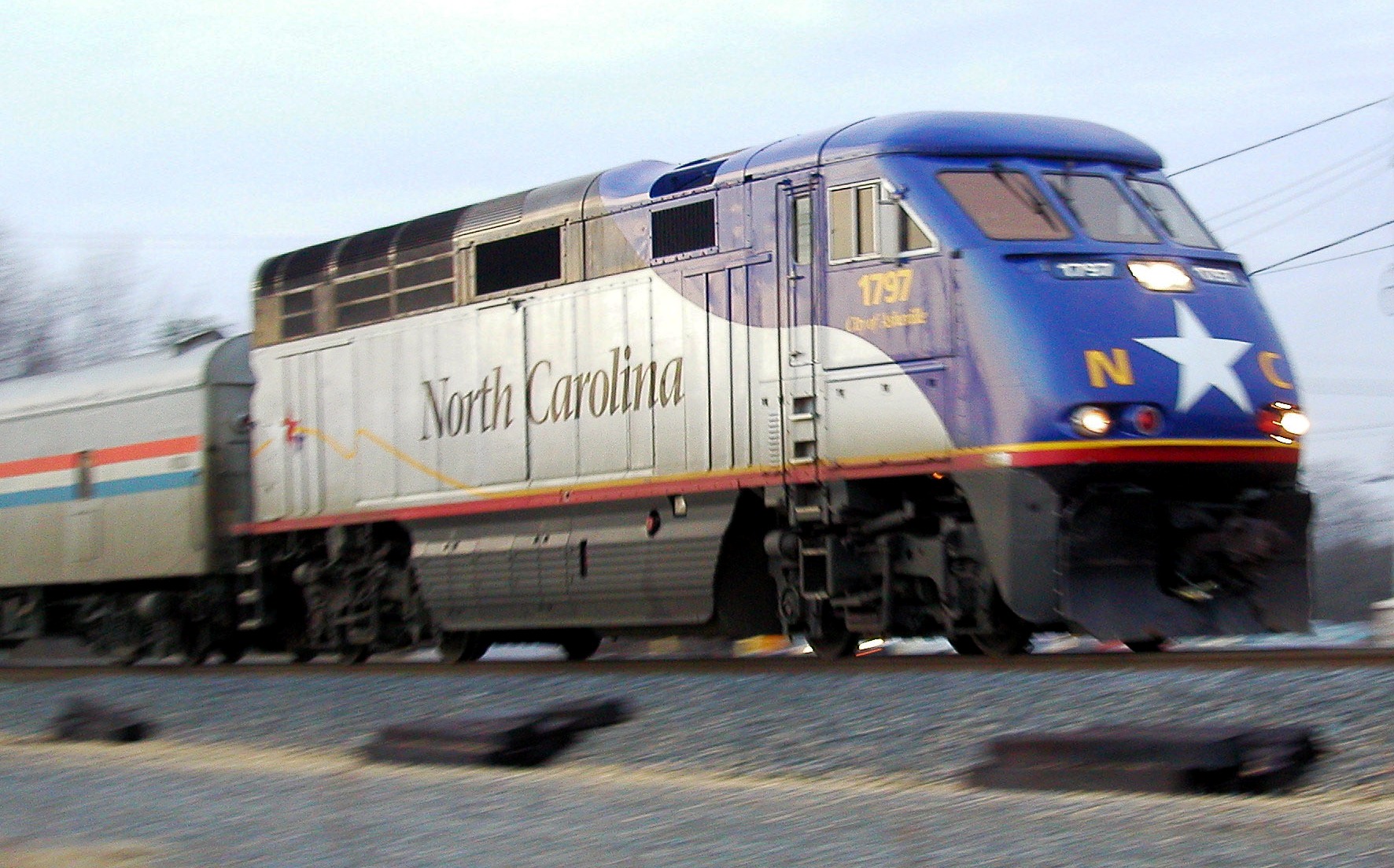Author's posts
Mar 03 2014
Sunday Train: The Ends of Amtrak
 At the beginning of last month, Paul Druce of “Reason & Rail” discussed the possible impact of the pending upgrade of the Amtrak Acela route in Acela II is the path towards Amtrak operational self-sustainability:
At the beginning of last month, Paul Druce of “Reason & Rail” discussed the possible impact of the pending upgrade of the Amtrak Acela route in Acela II is the path towards Amtrak operational self-sustainability:
The forthcoming Acela II isn’t just supposed to be significantly faster than the current Acela service, cutting 24 minutes from the scheduled time between Washington and New York and 38 minutes between Washington and Boston, but it will also represent a significant boost in capacity. …
With an increase in seating capacity, Amtrak will be able to garner significantly more revenue, even if it lowers the price of Acela seating somewhat. This added revenue comes with no significant increase in operational cost and quite possibly a lowered cost, as there should be a higher rate of availability and lowered mechanical costs for what is essentially an off the shelf train, along with significantly lower energy consumption. With current averages for occupancy and passenger revenue unchanged, an Acela II train service could see $742 million in revenue, with $447 million in operational profit.
This will have an even larger effect upon Amtrak’s financial deficit than initially appears because starting in FY2014, the states bear a greater responsibility for the short distance train corridors. This had the affect of reducing Amtrak’s FY2014 budget request to only $373 million for the operating grant; 2013’s appropriation, by contrast, was $442 million.
Note that what Paul Druce refers to as “operational profit” is what I have been calling “operating surplus” in the Sunday Train, the surplus of revenues from operations over operating costs. This is nothing like an operational profit, at present, since a profit is a financial benefit from a difference between revenue and costs, and there is nothing in the current organization of the Acela services that make a surplus on their operations into a distinctive financial asset for any purpose … whether public or private.
Whether or not all or part of this operating surplus should be made into an operational profit is a question that goes to the heart of what is the purpose of Amtrak. The way that this surplus is spent can be the means to service a range of ends … but what are the ends that are a legitimate use of these means?
Since Amtrak was established, and exists, as a political compromise, this is not a question about what is the proper “End” for Amtrak activities, but what are the proper “Ends” for Amtrak activities.
Feb 24 2014
Sunday Train: Carolina High Speed Rail & The Piedmont Service
 The Southeast HSR corridor can be divided between the “real” SEHSR corridor, where there is actual, ongoing work on improving the speed and, even more critically, the capacity of the corridor in support of services that will begin operating within the current decade, and the “notional” SEHSR corridor, the land of feasibility studies and preliminary planning, where even if a pedal to the metal intercity rail investment program were to commence in 2017, any new services entering into operation before the latter half of next decade would be subsidized conventional rail service.
The Southeast HSR corridor can be divided between the “real” SEHSR corridor, where there is actual, ongoing work on improving the speed and, even more critically, the capacity of the corridor in support of services that will begin operating within the current decade, and the “notional” SEHSR corridor, the land of feasibility studies and preliminary planning, where even if a pedal to the metal intercity rail investment program were to commence in 2017, any new services entering into operation before the latter half of next decade would be subsidized conventional rail service.
And given the importance of state governments in the current bottom-up process of intercity rail development, it should be unsurprising that the boundary between the two part of the SEHSR runs quite close to a state boundary. As discussed two weeks ago, Georgia lies in the middle of “notional” SEHSR country, with Rapid Rail connections to Birmingham; Columbus, GA; Savanna; Charlotte, NC; and Chattanooga / Nashville / Louisville at various stages of being studied, but without active ongoing investment. By contrast, there is current active investment and planned roll-out of new service throughout Virginia and North Carolina, all the way through to Charlotte, NC.
One reason that Virginia and North Carolina are engaged in ongoing investment is that they are well positioned for incremental development of Rapid Rail passenger service, with a legacy of through Amtrak corridors providing a platform to build upon, urban development taking place along urban arcs in both states, and close enough to the growing major metropolitan center of Washington, DC to use Washington as an anchor for longer distance intercity transport.
The greatest current focus of investment in the “real SEHSR” is the Piedmont Corridor in North Carolina, which is the focus of this week’s Sunday Train.
Feb 17 2014
Sunday Train: Portfolio Theory vs the Myth of Intermittent Wind Power
 This last week, in the comment section of the EnergyCollective, I saw the same myth that I have seen time and time again regarding wind power:
This last week, in the comment section of the EnergyCollective, I saw the same myth that I have seen time and time again regarding wind power:
Fact 1: renewables are aleatorically intermittent, and so unreliable.
Fact 2: due to Fact 1, they cannot provide energy when it is needed, but only when and in the quantity they can
Fact 3: users have to get energy when they need it, not when it is aleatorically provided
Fact 4: to date, there is no storage system that can be useful for a complex industrial society
Fact 5: due to facts 1 to 4, renewables need to have a back up system that can cope with the needs of the users.
Fact 6: that back up system cannot be just stopped and then put to generation in a few seconds or minutes, and usually have to generate at low efficiency to maintain the back up at call point, generating added costs, besides the usuals as maintainance, lost profits, complex distribution grid, etc.
… not surprisingly ending with climate crisis denialism in “Fact” 8, since the name of the game here is clearly not arguing by starting with facts and seeing what conclusion you arrive it, but rather is myth creation and propagation in support of an already selected conclusion.
While many people don’t know what “aleatorically” means, many would actually share the misconception that windpower is an intrinsically intermittent resource. However, for wind power, the “Fact 1” is in many cases “Falsehood 1”. Even though individual wind turbines are intermittent, for many wind resource regions, it turns out that a substantial share of wind power is not intermittent at all, in either their “by chance (aleatorically) and unpredictable” component or their “by chance (aleatorically), though predictable” component.
Feb 10 2014
Sunday Train: Taking That High Speed Train in Georgia
 I saw this news back in early January (Columbus Ledger-Enquirer 8 Jan 2014):
I saw this news back in early January (Columbus Ledger-Enquirer 8 Jan 2014):
A high speed rail line between Columbus and Atlanta would cost between $1.3-$3.9 billion over the next 20 years to build, but once up and running would more than pay for its operations and maintenance, a consultant said today.
It could also have a huge economic impact, according to Kirsten Berry, project manager consulting firm HNTB Corp., which performed the $350,000 study of the economic feasibility study of high speed rail between Columbus and Atlanta. The study was funded with a $300,000 Georgia Department of Transportation grant and the rest in private donations, according to city Director of Planning Rick Jones.
Now, the actual feasibility study itself has not been released, although the overview presentation to the Columbus GA stakeholders has been released, and I was going to wait until that feasibility study was available to talk about this on the Sunday Train. But then this happened:
Atlanta (CNN) — Empty streets, shuttered storefronts and abandoned vehicles littering the side of the road. That was the scene across much of metropolitan Atlanta on Wednesday as people hunkered down to wait out the aftermath of a snow and ice storm that brought the nation’s ninth-largest metropolitan area to a screeching halt.
… and given the severe state of auto-dependency in the greater Atlanta area, I concluded that the state of plans for HSR in Georgia merits a closer look.
Feb 03 2014
Sunday Train: The Central Flaw of the Keystone XL Economic Analysis
 Well, Sunday Train has the analysis of a couple of intercity rail projects in the queue, but for a weekly column devoted to renewable energy and transport issues to focus on some early stage preliminary analysis of an intercity rail corridor while ignoring the release of the updated final environmental impact analysis would be like some supposed weekend “in depth analysis” new show to ignore the release of that analysis in favor of covering the breaking news that New Jersey politicians play dirty (true story).
Well, Sunday Train has the analysis of a couple of intercity rail projects in the queue, but for a weekly column devoted to renewable energy and transport issues to focus on some early stage preliminary analysis of an intercity rail corridor while ignoring the release of the updated final environmental impact analysis would be like some supposed weekend “in depth analysis” new show to ignore the release of that analysis in favor of covering the breaking news that New Jersey politicians play dirty (true story).
For those who have been following the process, the conclusions of the updated analysis are of little surprise, since they basically repeat the previous conclusion before the analysts ~ analysts connected to the oil industry, since, of course, they would know about this kind of stuff ~ were told to repeat the analysis. That is, to quote part of the Think Progress Coverage:
The newly-released report admits to the obvious: that “the total direct and indirect emissions” of the project “would contribute to cumulative global GHG emissions.” But in its final analysis, it says the proposed pipeline is “unlikely to significantly affect the rate of extraction in oil sands areas,” and does not look at the overall greenhouse gas emissions of the tar sands oil that would flow through it.
The underlying, unstated, premise of the entire environmental and economic impact is that we will in any event produce a large portion of the tar sands that are in the ground. And that implies, of course, that we are screwed: we have to adopt policies keep 80% of existing reserves of carbon based fossil fuels in the ground in order to have a prospect of keeping global warming under about three and a half degrees Fahrenheit and have at least some chance of avoiding the kind of catastrophic climate change that will eliminate the United States as a single national society and economy.
So the analysis, including unstated premise, is: “Assuming that the nations of the world do not impose adequate policies to avoid a catastrophe with costs that dwarf the entire presumed value of the tar sands deposits, this is the impact of building or not building the Keystone XL pipeline.”
But, what is the impact of building or not building the Keystone XL pipeline presuming that we do adopt policies that are adequate to keep 80% or more of current existing fossil fuel reserves in the ground? The analysis avoids that question entirely, even though the analysis delivers the numbers that allows use to evaluate those costs.
Jan 27 2014
Sunday Train: The Solar Photovoltaic Price Evolution Revolution
 In early December, the Guardian covered ALEC’s latest corporate-written attack on freedom, an effort to penalize households that place solar panels on their roof:
In early December, the Guardian covered ALEC’s latest corporate-written attack on freedom, an effort to penalize households that place solar panels on their roof:
An alliance of corporations and conservative activists is mobilising to penalise homeowners who install their own solar panels – casting them as “freeriders” – in a sweeping new offensive against renewable energy, the Guardian has learned. …
For 2014, Alec plans to promote a suite of model bills and resolutions aimed at blocking Barack Obama from cutting greenhouse gas emissions, and state governments from promoting the expansion of wind and solar power through regulations known as Renewable Portfolio Standards.
[Director of the Energy and Policy Institute Gabe] Elsner argued that after its bruising state battles in 2013, Alec was now focused on weakening – rather than seeking outright repeal – of the clean energy standards. “What we saw in 2013 was an attempt to repeal RPS laws, and when that failed … what we are seeing now is a strategy that appears to be pro- clean energy but would actually weaken those pro- clean energy laws by retreating to the lowest common denominator,” he said.
So, is there a particular reason why ALEC going after rooftop solar photo-voltaic installations now, after having to beat a retreat on its 2013 effort to win wholesale repeals of Renewable Energy Portfolio Standards? Why yes, there does appear to be a particular reason for going after the economics of rooftop solar PV.
Jan 26 2014
Economic Populist: The Health Care Exchanges & Plan A Health Care Reform
Also in Economic Populist: Orwell’s Catastrophic Gradualism and 0.1% Apologetic
 Private health insurance is an entirely unnecessary economic institution, whether a health care system is organized around public, co-operative, sole proprietary, private partnership, corporate not-for-profit or corporate for-profit provision of the health care services themselves. Therefore, the profits associated with private health insurance are a legacy rent extracted by private health insurers, protected by the backward-looking nature of our economic institutions, and the least justifiable of the institutional overheads that we pile on top of the necessary costs of providing health insurance.
Private health insurance is an entirely unnecessary economic institution, whether a health care system is organized around public, co-operative, sole proprietary, private partnership, corporate not-for-profit or corporate for-profit provision of the health care services themselves. Therefore, the profits associated with private health insurance are a legacy rent extracted by private health insurers, protected by the backward-looking nature of our economic institutions, and the least justifiable of the institutional overheads that we pile on top of the necessary costs of providing health insurance.
The purpose of an economic subsystem is to provide material support to the social system that contains it. We are social animals sharing a common humanity, and making the quality of access to medical care for different members of our society depend upon the size of income flows and wealth balances they can tap into betrays a fundamentally perverse set of priorities. Before our society allocates resources to production of luxuries for a wealthy few, or even the production of luxuries for an adequately well-off many, it should allocate resources to meet the Basic Needs of all.
The Affordable Care Act (ACA) quite deliberately attempted to solve as few of the institutional problems as feasible among the many that we in the US face in ensuring access to, provision of, and quality of our basic need of medical care, while still hoping to possibly delay or stave off the collapse of our system for financing health care services that was already in progress by 2009.
Therefore, even if the ACA succeeds in staving off that collapse, we are left with a health care system that needs further reform. And if the ACA merely succeeds in delaying that collapse, then that simply increases the urgency and necessity of solving additional institutional problems.
Thus the fundamental issue that the ACA faces. The fundamental issue is not the functioning of the web site for signing up for coverage. It is not the deliberate monkey-wrenching of our already thoroughly corrupted political system as a side-show to try to game the new system for maximum short-term profits (even at the risk of returning system of finance of health to its path of ongoing collapse). It is that even if the ACA “succeeds”, it succeeds in such in a reform with such limited ambitions that it inevitably requires much more to be done.
Jan 20 2014
Sunday Train: California Sierra Club Allies with Tea Party Against High Speed Rail
 It’s a quite odd alliance. The Sierra Club is fighting the Climate Suicide Club both on the side of Supply, with the fight against the Keystone XL pipeline as one example and the fight against the establishment of Coal Export Terminals in the Pacific Northwest and on the side of Demand, with the Beyond Oil campaign, which in the Green Transportation component promises among other points that: “The Sierra Club will:
It’s a quite odd alliance. The Sierra Club is fighting the Climate Suicide Club both on the side of Supply, with the fight against the Keystone XL pipeline as one example and the fight against the establishment of Coal Export Terminals in the Pacific Northwest and on the side of Demand, with the Beyond Oil campaign, which in the Green Transportation component promises among other points that: “The Sierra Club will:
- Ensure that all Americans have access to safe, affordable, clean transportation options. …”
And now the Director of Sierra Club California, Kathryn Phillips, has stepped up her attacks on the High Speed Rail project from “expressions of serious concern” to giving direct support for the attack from the Legislative Analyst’s Office that is working in concert with the Tea Party attack that is their most promising hope for killing the project :
“Inherent in AB 32 is that we need to act sooner rather than later,” said Kathryn Phillips, the Sierra Club’s California director. “The problem with taking that [cap-and-trade] money and applying it to high-speed rail is that we don’t anticipate that we’re going to get those benefits – reductions in greenhouse gas emissions – in the short-term. Given how urgent the problem is and has become, and how much we’re seeing the effects of climate change in this state, especially in water availability, it feels irresponsible to not apply that money to those programs that will get you greenhouse gas emissions reductions now.”
Given that we cannot feasibly arrive at a carbon neutral energy generation and transportation system within the next seven years, this implies that we should abandon the pursuit of a carbon neutral generation and transportation system and content ourselves with fighting for a slower rate of suicide as a national industrial economy than the faster rate of suicide that Big Oil, Big Coal and the rest of the Climate Suicide Club is pushing for.
Indeed, given that Sierra Club California had an official position in support of Prop1a which got the California HSR project moving , this could well be as strong an attack on the California HSR project that Kathryn Phillips is in a position to make.
Jan 13 2014
Sunday Train: The Rumored Death of Peak Oil Was Greatly Exaggerated
 From Earth Insight by Nafeez Ahmed, hostsed by the Gardian, Former BP geologist: peak oil is here and it will ‘break economies’:
From Earth Insight by Nafeez Ahmed, hostsed by the Gardian, Former BP geologist: peak oil is here and it will ‘break economies’:
Dr. Richard G. Miller, who worked for BP from 1985 before retiring in 2008, said that official data from the International Energy Agency (IEA), US Energy Information Administration (EIA), International Monetary Fund (IMF), among other sources, showed that conventional oil had most likely peaked around 2008.
Dr. Miller critiqued the official industry line that global reserves will last 53 years at current rates of consumption, pointing out that “peaking is the result of declining production rates, not declining reserves.” Despite new discoveries and increasing reliance on unconventional oil and gas, 37 countries are already post-peak, and global oil production is declining at about 4.1% per year, or 3.5 million barrels a day (b/d) per year:
“We need new production equal to a new Saudi Arabia every 3 to 4 years to maintain and grow supply… New discoveries have not matched consumption since 1986. We are drawing down on our reserves, even though reserves are apparently climbing every year. Reserves are growing due to better technology in old fields, raising the amount we can recover – but production is still falling at 4.1% p.a. [per annum].”
Dec 23 2013
Sunday Train: Bringing This Oil Tanker to a Halt
 Its been said that it takes miles for a fully-loaded super-tanker to come to a stop, because an ordinary stop takes 20 minutes, and even an emergency, or “crash”, stop takes 14 minutes. But that is less than the blink of an eye compared to the time it will take to bring the emissions of CO2 to a stop.
Its been said that it takes miles for a fully-loaded super-tanker to come to a stop, because an ordinary stop takes 20 minutes, and even an emergency, or “crash”, stop takes 14 minutes. But that is less than the blink of an eye compared to the time it will take to bring the emissions of CO2 to a stop.
As Do the Math reminds us, in order to have some plausible chance (far short of certainty, by the way) of leaving global warming at under the 3.6°F that implies that the already ongoing climate catastrophe tips over into the super-catastrophe range, we need to keep additional CO2 emissions at under 565 gigatons. And we have computed reserves equivalent to 2,795 gigatons. So we must, by hook or by crook, find a way to refrain from consuming 80% of our CO2.
For the US, our main focus has to be on our energy emissions due to petroleum, coal, and natural gas, since 85.7% of our total CO2 emissions are due to energy production. As of 2011 41% of our emissions from energy production comes from petroleum emissions, 34% from coal, and 24% from natural gas. Of that 41% due to petroleum, 15% is from domestic petroleum production, and 26% from petroleum imports. So if the United States were to today achieve petroleum independence from carbon-neutral energy sources and energy savings, and totally replace coal combustion with carbon-neutral energy sources and energy savings, that would save 60% of the 86% of emissions from energy production, or 52% of the total. We would “only” have to cut the remaining energy-related emissions and the 14% from other sources by 60% to get to an equal proportional share of an 80% reduction.
However, the target we have to aim at is more ambitious than this. First, fossil fuels are non-renewable, and our timeline for the persistence of CO2 in the atmosphere is around a century. We don’t have a century’s worth of fossil fuels at the current rate of global consumption, so cutting back our consumption by 80% of the present rate is not enough.
And second, because of the time that it will take to switch to a low carbon emissions society, it is highly likely that by the time that a low carbon emissions society is within reach, we will have already emitted close to 565 gigatons.
This is why our target is no longer a “low net carbon emissions” society, but a “zero net carbon emissions” society, since we’ve likely already passed the “ordinary stop” stopping distance, and are coming up upon the “crash stop” stopping distance.

Recent Comments